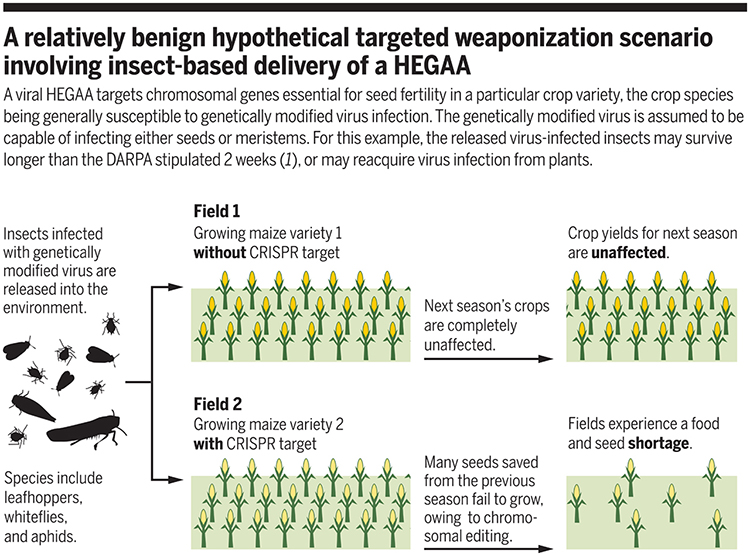Among the apocryphal quotes is that of Robert Oppenheimer, upon the detonation of the first atomic bomb: “Now I am become Death, the destroyer of worlds.” A policy discussion in Science echoes those concerns about horizontal environmental genetic alteration agents (HEGAA).
By now we have been inundated with stories about genetically modified crops, changes done the old fashioned way by crossbreeding or with newer methods of gene insertion and selective genetic alteration. Irrespective of the means, all of these changes are propagated vertically, from parent to offspring, generationally. Horizontal gene transfer does not require vertical propagation; it only requires a vector between one and another organism. The US Defense Advanced Research Projects Agency (DARPA), the people who brought you the Internet, in conjunction with academic agricultural centers [1], are looking at how to disperse crop genes horizontally through plant viruses [2]. Using a system like CRISPR, plant genes could be modified in the fields, to resist drought or other climatic change, or plant diseases – it could also be manipulated by “bad actors” to harm crops. And that is the concern of the authors; they want to avoid their Robert Oppenheimer moment.

Image courtesy of the authors
The fly in the ointment for the researchers is that the viral vector of genetic change is to be transmitted through insects rather than spraying. They point out that spraying would accomplish the same stated goals, so why insects? No one really knows the only hint of a reason is that “overhead spraying of HEGAAs would require infrastructure that is not available to all farmers.” The authors argue that at least for the US spraying is feasible and in the event of an emergency is readily scalable – think of all those planes and helicopters pouring water on forest wildfires. To bolster their point, they contend that most emergency measures to control plant pests are currently spray based, even when insect-based control measures are available.
The concern boils down to the question of intent, and the authors are questioning whether this technology will be used for good or evil. They do not trust the government on their face, nor do they trust the involved academics because of the lack of “publicly available assessments of the ethical, trade, biosafety, or international biosecurity implications…” They want to start a conversation by bringing the program to the public eye.
DARPA is designed to develop real-world applications; it is not in the basic science business. It is here to make us more secure – just as Oppenheimer’s work was designed to protect the homeland. It is difficult, if not impossible to judge intent. And while I agree with the authors that we should openly consider how our "science" is applied, Pandora’s box is already open; the techniques of gene transfer are freely available to those who seek the information. HEGAA as an insect vector will be developed. How it is used is outside the control of scientists; how the technology is shared is within the control of its creators. The populations that are affected exert their minimal control only through the governments and organizations they support. I believe that the authors are correct in that we need to discuss
[1] Penn State, Ohio State, the Boyce Thompson Institute (BTI), the University of Minnesota, the University of California, Davis, and Iowa State University
[2] The program is named Insect Allies – you gotta love the government for their names and acronyms.
Source: Agricultural research, or a new bioweapon system? Science DOI: 10.1126/science.aat7664

